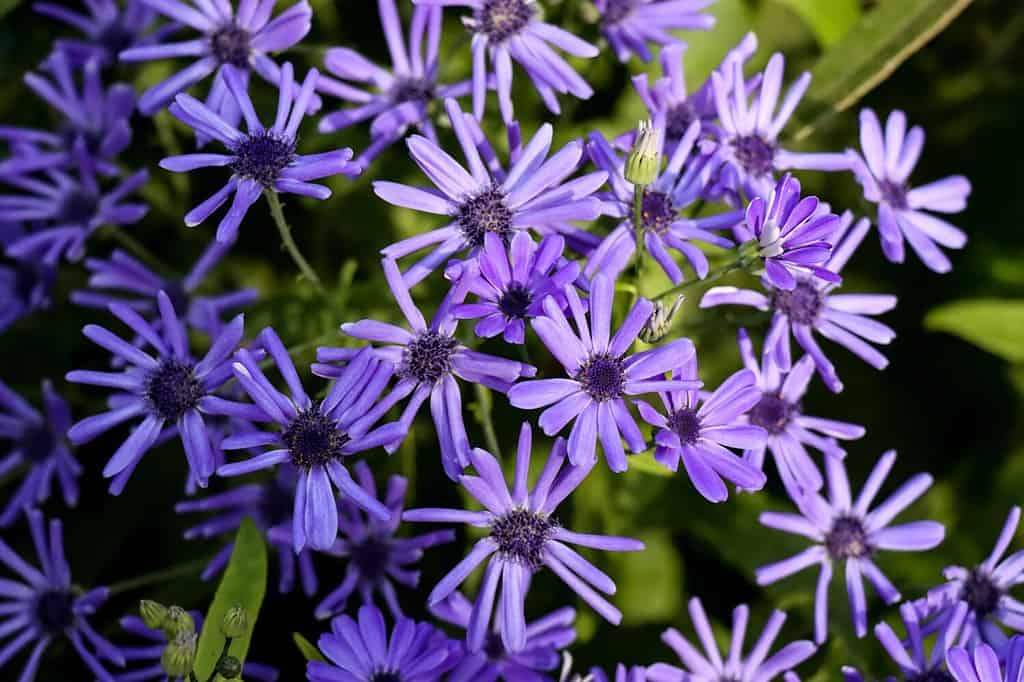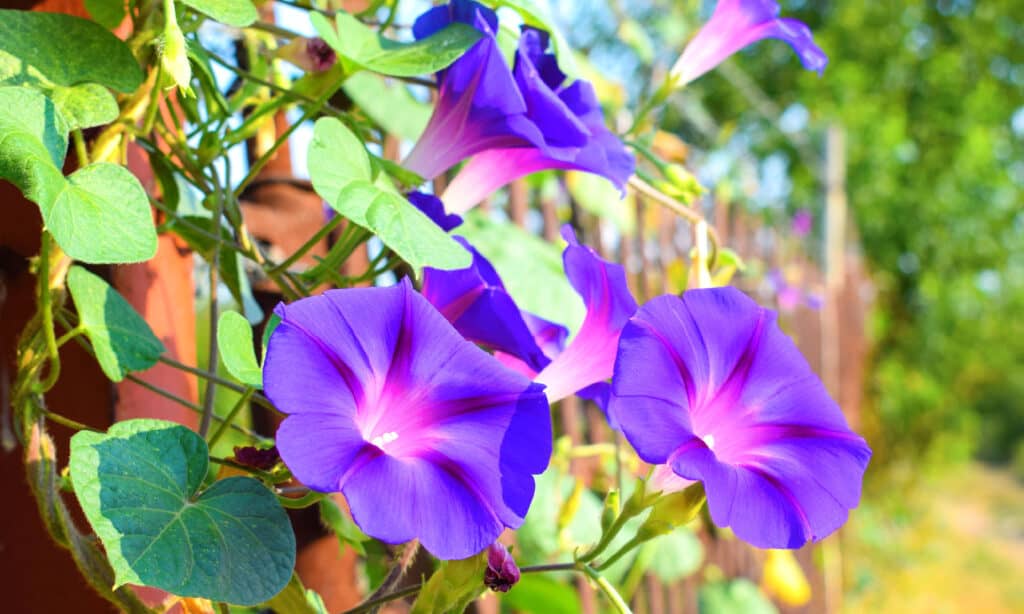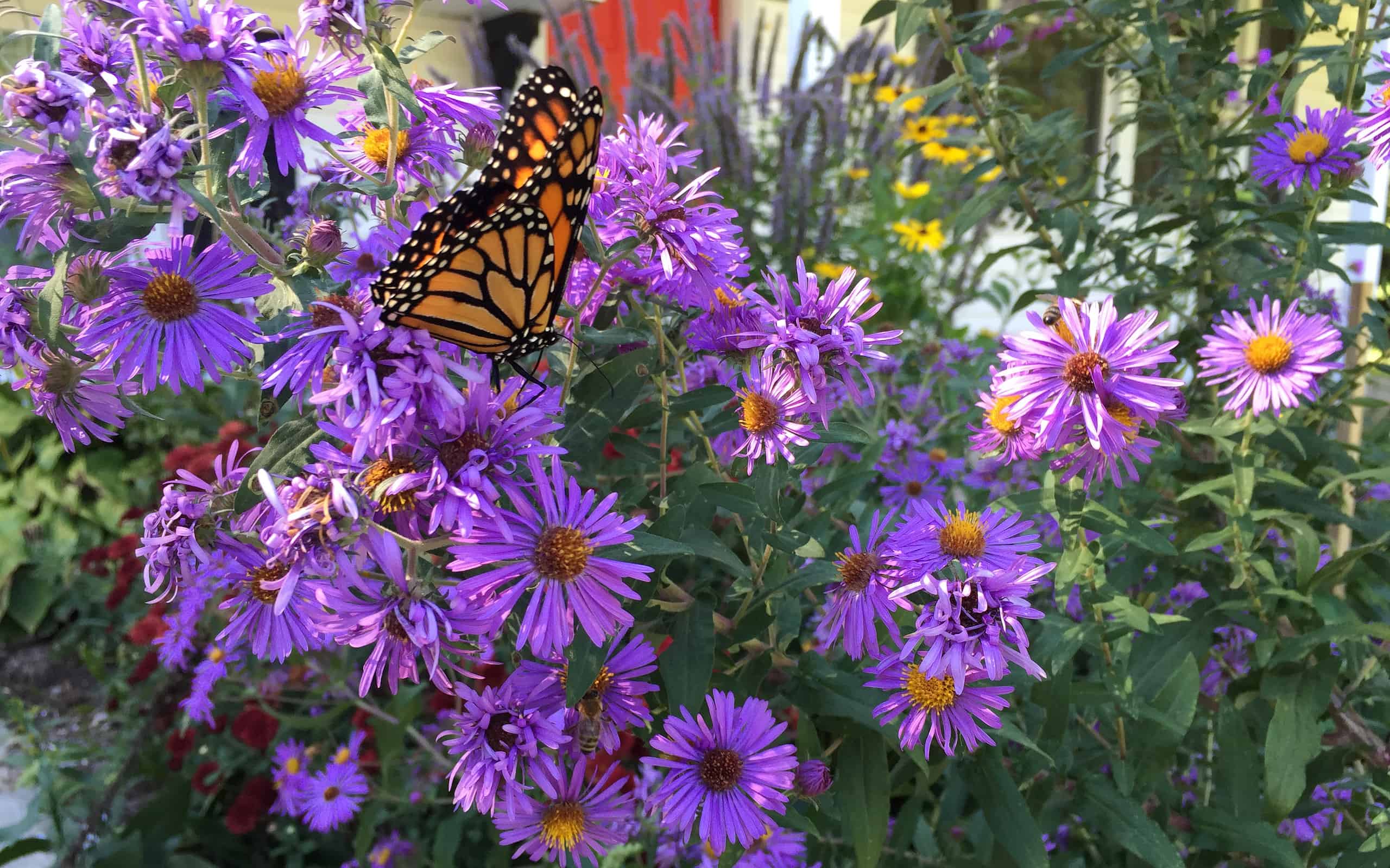September’s bloom brings forth a tapestry of vibrant hues and symbolic significance through its birth flowers. As summer’s warmth fades, three distinct blooms take the spotlight – the aster, the forget-me-not, and the morning glory. Let’s explore these unique flowers and what they actually mean as birth flowers.
Birth Flowers in September
There are three main flowers that are considered the birth flowers for those born in the month of September. However, morning glories are sometimes excluded from lists about September birth flowers, though they are widely considered to be a September birth flower.
Asters
Asters are flowering plants cherished for their vibrant, daisy-like blooms. They naturally thrive in North America, Europe, and Asia, gracing diverse habitats such as meadows, woodlands, fields, and gardens. These plants flaunt ray-like petals encircling a central disc of smaller florets, showcasing a spectrum of pink, purple, blue, and white hues that enliven landscapes during late summer and fall.
Caring for asters is relatively straightforward. They thrive in well-draining soil and appreciate ample sunlight, though some species tolerate partial shade. Adequate water during their growing season supports healthy development, and a layer of mulch helps conserve moisture and regulate soil temperature. Regular deadheading – the removal of spent flowers – encourages prolonged blooming and tidiness.
Dividing asters every few years prevents overcrowding and promotes better growth. Pinching back young shoots in early summer encourages bushier growth and more flowers. To safeguard against pests and diseases, proper spacing, good air circulation, and vigilant inspection are essential. Asters attract pollinators, such as bees and butterflies, making them beneficial additions to gardens.
Asters’ versatility suits various gardening purposes, including borders, beds, and containers. Their captivating appearance and ecological contributions render asters a popular choice for both natural landscapes and cultivated gardens, a testament to their enduring appeal.
Forget-Me-Nots
Forget-me-nots are charming flowering plants recognized for their delicate beauty. They are native to Europe and Asia but have also found a home in various parts of North America. These plants exhibit small, five-petaled flowers that typically boast shades of blue, pink, or white. The flowers are clustered together in a dense formation, creating a lovely and eye-catching display.
Caring for forget-me-nots is relatively simple. They prefer moist soil and thrive in partially shaded areas, although they can also tolerate some sun. Regular watering is important, especially during dry spells, to maintain their lush growth and abundant blooms. Deadheading spent flowers encourages continuous flowering and prevents the plant from self-seeding excessively.
Forget-me-nots are known for their ability to self-seed, creating new plants each year. To manage their growth, it’s advisable to thin out the seedlings and provide enough space between plants. These plants are attractive to pollinators like bees, making them beneficial for garden ecosystems. Additionally, their low-growing nature makes them suitable for borders, rock gardens, and as ground covers.
Due to their sentimental symbolism and effortless care requirements, forget-me-nots hold a special place in gardens and landscapes. Their petite blossoms and adaptability contribute to their popularity, ensuring they remain a cherished choice for both experienced and novice gardeners alike.
Morning Glory Flowers
Morning glory flowers are captivating and colorful blooms appreciated for their vibrant appearance. Native to regions in North and South America, as well as some parts of Asia, these flowers are cherished for their distinctive funnel-shaped blossoms that unfurl in the morning sunlight, giving rise to their name. Their petals come in an array of shades, including blue, purple, pink, and white, creating an enchanting sight in gardens and landscapes.
Caring for morning glories involves providing them with well-draining soil and ample sunlight. These plants are annual vines that can quickly climb and cover trellises, fences, and other structures. Regular watering is essential, particularly during dry spells, to support their rapid growth and prolific blooming. Mulching around the base helps retain moisture and regulate soil temperature.
Morning glories are known for their ability to self-seed, creating new plants in subsequent years. To manage their growth, deadhead spent flowers and thin out excessive seedlings. These flowers are loved by pollinators like bees and butterflies, contributing to a diverse garden ecosystem. However, their rapid growth can sometimes lead to invasive tendencies, so it’s important to monitor their spread and prune as needed.
With their captivating beauty and straightforward care requirements, morning glories have become a favorite choice for many garden enthusiasts. Their ability to transform fences and trellises into vibrant, living displays makes them a popular addition to both casual and formal garden designs.
The Origin, Meaning, and Symbolism of Asters
Asters are delightful blooms with captivating hues. They hold a special place as the birth flowers for September. These charming flowers, native to various parts of North America, Europe, and Asia, have an intriguing history, meaningful symbolism, and a connection to those born in this vibrant autumn month.

There are many varieties and species of aster, such as the blue wood aster (pictured).
©Wirestock Creators/Shutterstock.com
Origin of Asters as Birth Flowers
The association of asters with the month of September dates back centuries. The name “aster” is derived from the Greek term meaning “star,” reflecting the flower’s star-like shape. In ancient Greece, people had the belief that the burning of aster leaves could shoo away evil spirits. As centuries passed, these flowers became closely linked with September, adorning gardens and landscapes during this transitional period from summer to fall.
Meaning and Symbolism
Asters carry a variety of meanings and symbols, making them an apt choice to represent September births. One of the primary meanings associated with asters is elegance and daintiness. The intricate arrangement of their petals creates a visual spectacle that exudes a sense of refinement and grace.
Furthermore, asters symbolize love and devotion, making them a thoughtful gift for expressing affection. In Victorian times, these flowers were often given to convey a message of patience, trust, and remembrance. The delicate appearance of asters serves as a reminder of cherished bonds and enduring affection.
Variety of Symbolism
Asters also bear cultural significance across different societies. In China, these flowers are associated with fidelity and wisdom, making them a common motif in art and literature. Native American tribes utilized asters for their medicinal properties, recognizing their potential to remedy various ailments. The rich tapestry of meanings woven around asters illustrates their diverse symbolism in cultures around the world.
September Birth Connection
The alignment of asters with September births brings forth a unique connection between these flowers and individuals born in this month. September marks the transition between summer and fall, embodying change, renewal, and the shifting of seasons. Asters, with their appearance during this period, reflect the dynamic nature of those born in September – adaptable, charming, and multifaceted in their personalities.
Just as well, the bloom of asters during September mirrors the qualities of balance and harmony often attributed to those born under this birth month. Just as asters bridge the gap between summer and fall, September-born individuals often find themselves navigating between different aspects of life, maintaining equilibrium in their endeavors.
Caring for Asters
For those seeking to nurture asters, proper care is essential to ensure their beauty thrives. Asters thrive in well-draining soil and appreciate a sunny spot in the garden. Adequate water during their growth phase promotes healthy development and abundant flowering.
Regular deadheading – the removal of spent flowers – encourages continuous blooming and maintains the overall appearance of the plant. This practice also prevents the plant from directing energy towards seed production, thereby promoting more prolific flowering.
The Origin, Meaning, and Symbolism of Forget-Me-Nots
The delicate charm of forget-me-nots graces the month of September as its birth flowers. These small yet enchanting blooms carry a history rich with significance, meaningful symbolism, and a deep connection to individuals born in this transitional month.

Forget-me-nots are very popular flowers for bouquets, weddings, and flower arranging in addition to being a September birth flower.
©Shulevskyy Volodymyr/Shutterstock.com
Origin of Forget-Me-Nots as Birth Flowers
The roots of forget-me-nots as September’s birth flowers extend back through time. These petite blossoms, known for their alluring blue hue, have captured hearts for centuries. Their name, derived from the German term “Vergissmeinnicht,” evokes a sense of remembrance and sentimentality. It is believed that forget-me-nots were first associated with true love during the medieval period, and their popularity grew over time.
Meaning and Symbolism
Forget-me-nots carry a poignant message of lasting affection and remembrance. These flowers symbolize enduring love and connections that transcend the passing of time. The delicate, five-petaled blossoms, often in shades of blue, evoke feelings of tenderness and devotion.
The symbolism of forget-me-nots extends beyond romantic love, encompassing friendship, loyalty, and the preservation of memories. These flowers are a heartfelt way to express sentiments of gratitude and appreciation, acknowledging the steadfast bonds that enrich our lives.
Connection to Birth Month
The alignment of forget-me-nots with September births holds profound significance. As the transitional month between summer and autumn, September represents change, growth, and new beginnings. Forget-me-nots, with their captivating blooms, mirror this theme of transition and renewal.
Individuals born in September often possess qualities of adaptability, balance, and a deep appreciation for relationships. Much like forget-me-nots thrive in diverse environments, September-born individuals navigate life’s transitions with grace and resilience, forging connections that withstand the test of time.
Cultural and Historical Significance
Forget-me-nots have left an indelible mark on various cultures and historical contexts. These flowers were adopted as a symbol of remembrance after World War I, honoring those who had fallen in battle. The blue blossoms came to represent the memories of loved ones left behind, a poignant emblem of sacrifice and enduring ties.
In folklore, forget-me-nots were believed to possess magical properties that offered protection against forgetfulness and fostered harmonious relationships. These tales underscore the flowers’ capacity to hold sentimental value and preserve cherished memories.
Caring for Forget-Me-Nots
Cultivating forget-me-nots requires attention to their specific needs. These flowers thrive in partially shaded areas with well-draining soil. Adequate watering is crucial, as their preference for consistently moist soil contributes to healthy growth and continuous flowering.
To encourage re-blooming, the practice of deadheading spent flowers is recommended. This not only prolongs the flowering period but also prevents the plant from diverting energy towards seed production. By maintaining their vibrant blooms, forget-me-nots serve as a living testament to the enduring connections they symbolize.
The Origin, Meaning, and Symbolism of Morning Glory Flowers
These captivating blossoms hold within their petals a fascinating history, deep-rooted symbolism, and a connection to the individuals born in September.

Morning glory flowers can come in a number of hues from red to yellow to blue to purple (pictured).
©iStock.com/Wakhron
Origin of Morning Glory Flowers as Birth Flowers
The enchanting allure of morning glory flowers dates back through the annals of time. With their trumpet-like blooms that unfurl in the morning sun, morning glories have held the fascination of cultures across the globe. Their name, derived from the Latin term “Ipomoea,” signifies their propensity to climb and twine, adorning landscapes with their vivid hues.
Meaning and Symbolism
Morning glory flowers bear meanings that echo the sentiments of September births. These blossoms symbolize affection, as well as the renewal and rejuvenation associated with the dawn. Just as morning glories bloom anew each day, they embody the themes of fresh beginnings and embracing change.
Moreover, morning glories are imbued with connotations of love, spirituality, and positivity. Their ability to climb upwards reflects the aspiration to reach higher realms and attain personal growth. Their fleeting yet captivating blooms encapsulate the essence of appreciating life’s fleeting moments.
Alignment with the September Birth Month
Morning glory flowers align with September births in a manner that reflects the qualities of those born during this time. September heralds the transition from summer to fall, a period of change and transformation. Morning glories mirror this transition, unfurling their petals as the sun rises, symbolizing the journey from darkness to light.
Individuals born in September often possess traits of adaptability, curiosity, and a thirst for knowledge. Similar to the way morning glories stretch towards the sun, September-born individuals seek to explore and expand their horizons, embracing life’s challenges and opportunities.
Cultural and Historical Significance
Morning glory flowers have found their place in various cultures and historical narratives. In Chinese folklore, they are associated with a tale of love and separation, where the flowers symbolize the bond between two lovers separated by the Milky Way. This poignant story has etched morning glories into cultural lore, connecting them with themes of devotion and longing.
In some indigenous traditions, morning glories have been used for medicinal and ceremonial purposes. Their inclusion in rituals underscores their significance as agents of transformation and renewal.
Caring for Morning Glory Flowers
Nurturing morning glory flowers requires attention to their growth requirements. These vines thrive in well-draining soil and flourish in areas that receive full sun. Regular watering, especially during dry spells, is essential to sustain their growth and flowering. Providing a trellis or support allows morning glories to climb and showcase their blooms effectively.
Pruning and deadheading spent flowers promote continuous blooming and prevent the plant from diverting energy towards seed production. Careful monitoring is necessary, as morning glories’ rapid growth can sometimes lead to invasive tendencies, potentially competing with other plants in the garden.
In conclusion, the September birth flowers – asters, forget-me-nots, and morning glories – weave a tapestry of beauty, meaning, and symbolism. Asters reflect elegance and love, forget-me-nots carry sentiments of remembrance and enduring bonds, while morning glories symbolize new beginnings and growth. These blooms mirror the essence of September, a month of transition and transformation. Just as flowers bloom and change with the seasons, those born in September embrace life’s shifts with grace. As we admire these blossoms, let us also appreciate the unique qualities that September-born individuals bring to the world, enriching our lives with their spirit and charm.
Thank you for reading! Have some feedback for us? Contact the AZ Animals editorial team.








